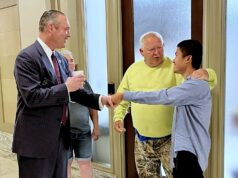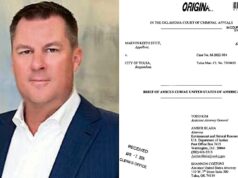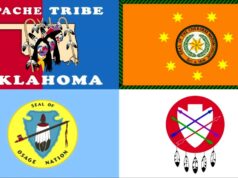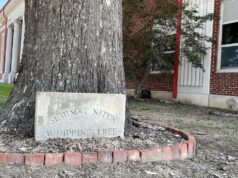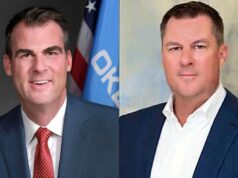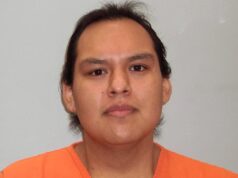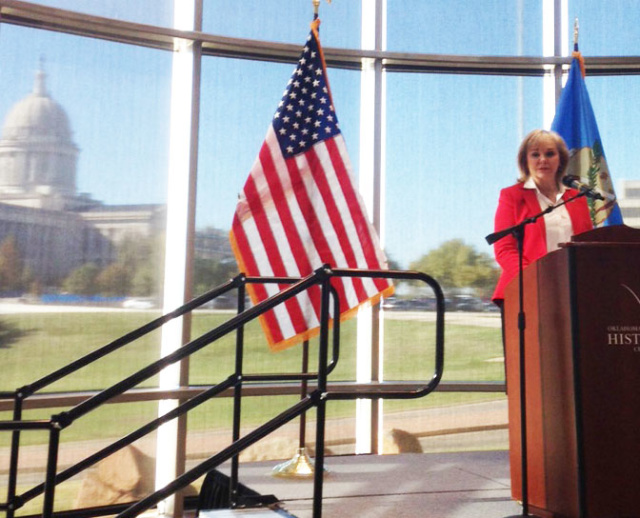

Gov. Mary Fallin and Department of Health and Human Services director Ed Lake are asking volunteer foster parents, Native American tribes, businesses, churches and non-profits to meet a challenge: provide safe homes for some 11,000 children in state custody. The Oklahoma Fosters campaign seeks to recruit 1,000 new foster families by June 2016.
Recently, a new standard at DHS asked for 1,197 new family foster homes by the end of 2014, but DHS recruited only about 45 percent of the number. Fallin said that, frankly, the state fell short, and that we are living in a crisis. That’s why she presented the new initiative Thursday during a press conference at the Oklahoma History Center.
When asked if subsidies would be set aside for the Oklahoma Fosters initiative, Fallin pointed to details within DHS’s FY-2015 budget, which totals $675 million. For FY-2016, it is $679 million, and the governor said she has increased the number of workers at the agency.
Later, DHS director Ed Lake said changes would need to be made to the DHS budget, and DHS officials emphasized that the state may even attempt to increase the rates it pays foster parents.
But for the size of the foster-parenting challenge, Fallin said leaders have to reach beyond state resources.
“We’ll take everybody and anybody,” she said during her speech Thursday. “We’re facing some major shortfalls. We know that Oklahomans are great people that help their fellow neighbors. Just as you heard some of the parents talking about today, some of the faith organizations talking about, there is a role for people to play. I think if you tell people there is a need, they will step up to help. You just gotta tell them what the need is.”
The Pinnacle Plan
The Oklahoma Fosters initiative follows DHS’ Pinnacle Plan, undertaken by DHS to improve care of children in state custody. The Pinnacle Plan was a direct response to a settled class-action lawsuit where nine plaintiffs told of overcrowded emergency shelters, a child being relocated up to 20 times, and placements in abusive homes that went under supervised by DHS workers.
“Which is one of the reasons why we put such a focus on recruiting new caseworkers in our Pinnacle Plan, because we haven’t had enough,” Fallin said. “We have a lot of children that have some type of crisis going on in Oklahoma for many, many different reasons. … Our effort today is to bring together partnerships throughout the state, all groups helping us to have a better future for our children of Oklahoma.”
By the plan, the goal for net gain of therapeutic homes in 2015 was set at 56. As of June, they’ve had a net gain of 19. For new foster homes, 739 new homes opened, which is 82 percent of the 904 goal. According to a recent report on the Pinnacle Plan, Oklahoma DHS also fell short in the number of foster children placed in permanent homes.
In compliance with the Pinnacle Plan, DHS releases a monthly report on new foster homes, shelter use, safety and worker contracts, to measure the progress made. The results show, for example, 164 children ages 6 to 12 who spent a total of 2,805 nights in a shelter as opposed to the 225 children who spent 3,894 nights in shelters during June 2014.
The reports measure the performances of workers as well. Forty-nine percent of child-welfare workers, for example, met their caseload standards, but 41 percent were overworked. Forty-seven percent of workers focused on permanent housing planning had workloads that were over capacity.
Appropriations specifically for the Pinnacle Plan have increased from $25 million in FY-2013 to $109 million for FY-2016.
Voice from a permanent home
All of Thursday’s speakers were humbled by a testimony from Marissa Ibarra-Reyes, 17, a product of the DHS and foster care system (and, as she told NonDoc, an aspiring writer). Her father, a drug dealer, was murdered when Ibarra-Reyes was 4. As a child, she suffered the intermittent traumas of physical, emotional and sexual abuse from people she trusted. In the fourth grade, she started using drugs, access to which was easy with her mother being an addict. The mother also had trouble paying bills and resorted to prostitution. Moving from place to place, she had a realization in Texas.
“One day, I was going into the restroom,” Ibarra-Reyes said to a crowded conference hall. “I looked at myself. And I just questioned myself. ‘Is this who you really want to be? Look at yourself. There has to be something more in this life other than just doing drugs every day, doing the same thing every day.’
“I didn’t want to drop out. I didn’t want to work minimum-wage jobs the rest of my life the way my mom did. I wanted to do better than that. I cried and prayed out to God because, growing up, my aunt would say stuff about God, and I never really understood it, but I knew that I didn’t have anywhere else to go.”
She returned to Oklahoma, where her mother was eventually arrested. Thus began her foster-care odyssey. She was initially put into a placement, but the family wasn’t able to take care of her. Over the next year and a half, Reyes bounced around foster homes and shelters, seven months of which was spent in a youth shelter. Then she found the Ibarra-Reyes family, which still fosters new children.
“Two years ago I would’ve never imagined having three brothers, one adopted baby lovely sister, two dogs and a loving mother and father,” she said, stifling a cry, before opening up a prayer for the unadopted.
“Please help us to realize what is really going on in this world,” she said, “to just love on the kids the way that they need to be loved. Please help us to keep our ears open to the messages we are going to hear today.”
Ibarra-Reyes told NonDoc that words could not express the happiness she felt when she found her family, and that the family’s approach to the process eased her mind.
“The thing that was different [from the first foster family] is that they slowly built a relationship. More calls, visits, overnights, things like that” she said. “It wasn’t as awkward.”
Caseworker turnover still high
By October (as Fallin previously mentioned), DHS hired 326 new child welfare specialists. Caseworkers are meeting their required monthly visits with the children assigned to them, however, the increase in specialists has failed to lower the rate at which children are abused or neglected, and it hasn’t developed enough therapeutic foster homes — homes specially trained to shelter kids with emotional or behavioral needs.
A caseworker’s load, which can average 20 to 30 families at a time, becomes immediately more stressful to handle when a family releases a child (a potentiality when there’s trauma or behavioral issues). A 2014 report by Casey Family Programs showed caseworker turnover was still high (most lasting less than a year). DHS hired 600 front-line workers, but their inexperience was unduly tested as cases grew.
The stress put on child welfare specialists can’t be understated. In 2011, child-welfare specialist Donald Wheeler killed himself after a 5-year-old girl under his supervision was beaten to death by her biological father, whose home Wheeler’s caseworkers had recommended the girl to be placed. Wheeler was a 24-year veteran of DHS.
Faith-based fostering represents paradigm shift
With budget shortfalls on the state level, Fallin is banking on the cooperation of people like Chris Campbell. Campbell is the director of 111 Project, an organization dedicated to getting one foster family from each church in the state to become foster parents, thereby alleviating the statewide need. The 111 Project represents a paradigm shift in foster-care culture: More faith-based or contract agencies are taking on clients, with the result that children get caseworkers with more time.
The shift is rapidly moving children away from shelters and into more families. As proof, OKC is preparing to close the Pauline H. Mayer shelter, possibly as early as next week.
“We haven’t tried this,” said Sheree Powell, DHS director of communications. “This is being run like a grassroots effort.”
Powell said faith-based groups will be huge, as will philanthropic groups and business leaders. Her example of a successful business collaboration was Chesapeake Energy quietly donating employee labor at a shelter near its campus. Employees would take lunch breaks to rock babies, Powell said.
Tribal involvement
Leaders from the Cherokee Nation were also in attendance during Thursday’s launch. The nation has three people dedicated to recruitment, while the Creek nation has two recruiters. Recently, 31 new tribal homes were added, according to Jacque Hensley, tribal liaison to Oklahoma Fosters.
“This is a time when we are all going to come together,” Hensley said.
Native children in state custody also pose more complicated guardianship questions. On Nov. 1, HB 1834 took effect, which requires the Office of Juvenile Affairs or any county juvenile bureau to inquire as to whether a child being processed into state custody has American Indian lineage. If a child does, the office or county bureau must notify the corresponding tribe within 24 hours.
(Editor’s Note: This story was corrected to accurately reflect the Pauline H. Mayer shelter’s impending closure and Chesapeake employees’ volunteer efforts there. Numbers related to DHS’s budget were also clarified.)









